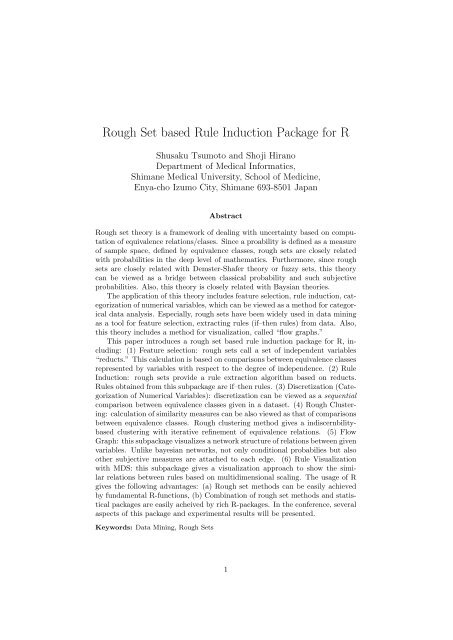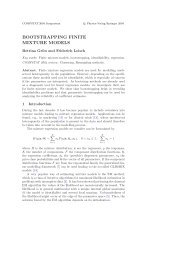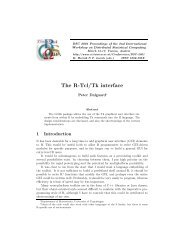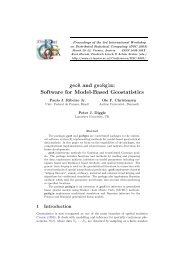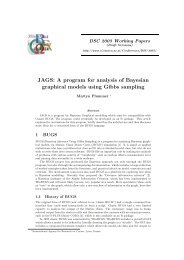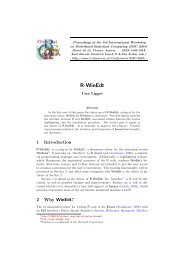Embedding R in Windows applications, and executing R remotely
Embedding R in Windows applications, and executing R remotely
Embedding R in Windows applications, and executing R remotely
You also want an ePaper? Increase the reach of your titles
YUMPU automatically turns print PDFs into web optimized ePapers that Google loves.
Rough Set based Rule Induction Package for R<br />
Shusaku Tsumoto <strong>and</strong> Shoji Hirano<br />
Department of Medical Informatics,<br />
Shimane Medical University, School of Medic<strong>in</strong>e,<br />
Enya-cho Izumo City, Shimane 693-8501 Japan<br />
Abstract<br />
Rough set theory is a framework of deal<strong>in</strong>g with uncerta<strong>in</strong>ty based on computation<br />
of equivalence relations/clases. S<strong>in</strong>ce a proability is def<strong>in</strong>ed as a measure<br />
of sample space, def<strong>in</strong>ed by equivalence classes, rough sets are closely related<br />
with probabilities <strong>in</strong> the deep level of mathematics. Furthermore, s<strong>in</strong>ce rough<br />
sets are closely related with Demster-Shafer theory or fuzzy sets, this theory<br />
can be viewed as a bridge between classical probability <strong>and</strong> such subjective<br />
probabilities. Also, this theory is closely related with Baysian theories.<br />
The application of this theory <strong>in</strong>cludes feature selection, rule <strong>in</strong>duction, categorization<br />
of numerical variables, which can be viewed as a method for categorical<br />
data analysis. Especially, rough sets have been widely used <strong>in</strong> data m<strong>in</strong><strong>in</strong>g<br />
as a tool for feature selection, extract<strong>in</strong>g rules (if–then rules) from data. Also,<br />
this theory <strong>in</strong>cludes a method for visualization, called “flow graphs.”<br />
This paper <strong>in</strong>troduces a rough set based rule <strong>in</strong>duction package for R, <strong>in</strong>clud<strong>in</strong>g:<br />
(1) Feature selection: rough sets call a set of <strong>in</strong>dependent variables<br />
“reducts.” This calculation is based on comparisons between equivalence classes<br />
represented by variables with respect to the degree of <strong>in</strong>dependence. (2) Rule<br />
Induction: rough sets provide a rule extraction algorithm based on reducts.<br />
Rules obta<strong>in</strong>ed from this subpackage are if–then rules. (3) Discretization (Categorization<br />
of Numerical Variables): discretization can be viewed as a sequential<br />
comparison between equivalence classes given <strong>in</strong> a dataset. (4) Rough Cluster<strong>in</strong>g:<br />
calculation of similarity measures can be also viewed as that of comparisons<br />
between equivalence classes. Rough cluster<strong>in</strong>g method gives a <strong>in</strong>discernbilitybased<br />
cluster<strong>in</strong>g with iterative ref<strong>in</strong>ement of equivalence relations. (5) Flow<br />
Graph: this subpackage visualizes a network structure of relations between given<br />
variables. Unlike bayesian networks, not only conditional probabilies but also<br />
other subjective measures are attached to each edge. (6) Rule Visualization<br />
with MDS: this subpackage gives a visualization approach to show the similar<br />
relations between rules based on multidimensional scal<strong>in</strong>g. The usage of R<br />
gives the follow<strong>in</strong>g advantages: (a) Rough set methods can be easily achieved<br />
by fundamental R-functions, (b) Comb<strong>in</strong>ation of rough set methods <strong>and</strong> statistical<br />
packages are easily acheived by rich R-packages. In the conference, several<br />
aspects of this package <strong>and</strong> experimental results will be presented.<br />
Keywords: Data M<strong>in</strong><strong>in</strong>g, Rough Sets<br />
1


